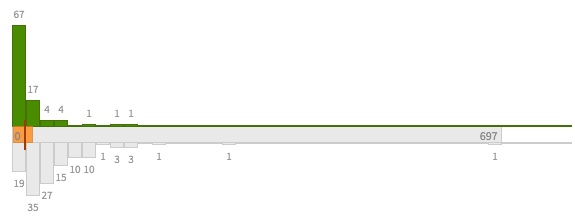- November 5, 2015
- Posted by: Dave Kurlan
- Category: Understanding the Sales Force

Yesterday I was looking at the dashboard in my new car and noticed that one of the gauges could be swapped out. There aren’t any fixed gauges on this dash because the gauges, ranges and needles are displayed digitally. I can even change their color! The thing that caught my interest though, was the flashlight effect where the ticks to either side of the needle are brighter and bolder to draw attention to where the needle is pointing. That got me thinking about the dashboards for my company. I looked at the dashboards for Kurlan & Associates and because of what I saw, I wrote this article.
We use Membrain for our CRM/Opportunity/Pipeline Management system because it’s the one we recommend most often to our clients and if we’re going to recommend a CRM application, shouldn’t it be the one we use, embrace and love?
While changing the filters for one of the graphs, I noticed some things that I hadn’t noticed the last time I checked in. And I promise, the things I noticed are probably occurring at your company too. The question is, can your CRM application let you know (and do you know) what to do next? So here’s what I found that was so interesting.
In the past two months, there were 40 new opportunities added, bringing the number of active opportunities in the pipeline to 80. That’s an average of 1 new opportunity per person, per week, which is exactly what it should be in our business. So that’s good. But I also noticed this:
There are currently 16 highly probable, closable opportunities representing 20% of the pipeline which is a lot better than what we normally see. For instance, for every 2 new clients, it historically requires the following:
- 20 suspects that convert to,
- 10 prospects that convert to,
- 5 qualified opportunities that convert to,
- 3 closable opportunities.
In other words, only 10% of the prospects we begin talking with typically become clients. Not because we aren’t effective or that prospective clients go with other companies; but mostly because half of the 20 suspects we start conversations with are either the wrong person for us to be speaking with or there isn’t a good fit and we disqualify them! Similarly, we often disqualify half of the remaining 10 prospects because they don’t have or won’t spend the money to work with us. That’s how we get from 20 to 5. And as with any business, we don’t close every one. Some decide to do nothing at all and once in a blue moon, a prospect chooses to go with another company.
I also noted that there was forward progress made on 58 opportunities – meaning that no single opportunity is sucking up the team’s time or resources at the expense of other opportunities.
The metric that really stuck out for me though was that 22 of the 80 opportunities were stalled. They had exceeded the baseline number of days allowed for an opportunity to remain in a particular stage of the sales process and our dashboard in Membrain has some very compelling data about opportunities that stall. The image below represents the graph of stalled opportunities. Green represents an opportunity that we closed and gray represents one that we archived or lost.

This small red line in this graph indicates that when an opportunity stalls for more than 19 days, the chances of closing that business decrease dramatically, from 78% to less than 50%. It further illustrates that if an opportunity stalls beyond 35 days, there is very little chance that the opportunity will close, with the win rate dropping to just 10-15%.
So when I saw that there were 22 stalled opportunities, I dug a little further and found that all of them were stalled beyond 35 days. So the probability of any business occurring with these opportunities is already below 15%. Next I wanted to identify which stage of the pipeline they were stalled in. In Baseline Selling, we have 5 stages of the pipeline where opportunities are either:
- On Deck – 1st Meeting has not been scheduled.
- 1st Base – 1st Meeting has been scheduled but not yet held (Suspect).
- 2nd Base – 1st Meeting has been held and it is a real opportunity (Prospect).
- 3rd Base – Opportunity has been thoroughly qualififed (Qualified).
- On the Way Home – Opportunity is Closable (Closable).
I found that all but four of the stalled opportunities were on Deck. So either a lead had come in, someone had expressed interest or we were referred to the company but no meeting had been scheduled – after more than 35 days!
That’s the beginning of the process of reading a useful CRM dashboard. The data tells us where the problem is, who has the problem, and what we should be asking. In this case, one person – a very busy senior sales expert – was responsible for 36% of those stalled opportunities. So while we can understand how the business interfered with getting meetings scheduled, it is still not acceptable. The opportunities should have been handed off to a consultant on the team who isn’t as jammed with training, consulting and coaching as he is. In another case, one person was only responsible for 5%, or just 1 of the stalled opportunities. That’s good, right? No, it’s bad. Everything is relative. He doesn’t have as many opportunities in the pipeline as the others, so his 1 stalled isn’t an indicator that he’s moving things along as much as it’s an indicator that his pipeline is too small!
While most of my articles address sales selection, sales force evaluations, sales competencies, sales DNA, sales strategy, sales process and sales tactics, sometimes getting the pipeline right can make all the difference in the world. Of course, to get the pipeline right, you must have an application that gives you the right information, in an easy-to-access format. You also need an application that your salespeople embrace and always keep up-to-date so that you have real-time data. And finally, you must be willing to consistently review your dashboard and let it tell you a story. What story is your dashboard telling you today?
And before you comment, I’ll make the first one:
“Dave, you talk about consistently reviewing the dashboards, but in this case, you weren’t aware of the stalled opportunities until they were all beyond 35 days. Isn’t that hypocritcal you fat, old, sales guy?” Someone was going to write that so I figured I would save him the trouble. Yes, it would have been a male troll. And yes, I should have been on top of that, but I wasn’t this month. And hey, my mistake is your gain because it made for a good topic for the blog, didn’t it?
